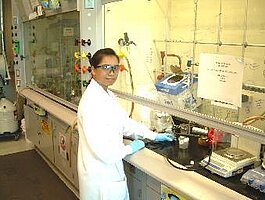Effective Delivery of Iron Nanoparticles by Amphiphilic Polysiloxane Graft Copolymeric Vehicles for Groundwater Remediation

Sita Krajangpan is a graduate student (Ph.D.) in Civil Engineering at North Dakota State University. She holds a Master of Science degree in Environmental and Hazardous Waste Management (Chulalongkorn University, Bangkok, Thailand, 2005), a bachelor’s degree in Environmental Science (Chulalongkorn University, 2002) and a diploma in Analytical Chemistry (Chulalongkorn University, 2000). Currently, her research is focused on developing an effective metal nanoparticle delivery system for in-situ remediation of groundwater contaminants.
Email: sita.krajangpan@ndsu.edu
Phone: 701-429-3284
Fellow: Sita Krajangpan
Advisor: Achintya Bezbaruah, Ph.D., Assistant Professor, Department of Civil Engineering, North Dakota State University
Co-Advisor: Bret Chisholm, Senior Research Scientist, Center for Nanoscale Science and Engineering, North Dakota State University
Matching Support: North Dakota State University .
Degree Progress: Ph.D. in Environmental Engineering expected in Spring 2009.
Effective Delivery of Iron Nanoparticles by Amphiphilic Polysiloxane Graft Copolymeric Vehicles for Groundwater Remediation
Zero valent iron (Fe 0) nanoparticles (NZVI) have been used for groundwater remediation of various contaminants because of their unique physiochemical properties. Various chlorinated aliphatic hydrocarbons, explosive material, and arsenic have been successfully decontaminated by NZVI. However, NZVI are not only highly reactive with the contaminants, but also rapidly react with surrounding media in the subsurface (dissolved oxygen and/or water) and other non-target compounds. Thus, significant loss of NZVI reactivity occurs before the particles reach the target contaminant. Additionally, strong magnetic interaction between particles causes agglomeration, limiting colloidal stability and reduction in reactive surface. Considering the requirements of an effective delivery system for NZVI, functionalized amphiphilic polysiloxanes are an ideal class of polymers for this application. Amphiphilic polysiloxane graft copolymers (APGCs) have been synthesized by hydrosilylation of hydride-functional polysiloxanes, poly ethylene glycol (PEG) and tert-butyl acrylate (tBA). Anchoring groups and carboxylic acid groups, in conjunction with the polysiloxane polymer backbone, will allow for efficient absorption of polymer molecules to the surface of the NZVI while the water-soluble grafts, PEG, will allow for dispersibility and colloidal stability in an aqueous medium. The hydrophobicity of the polysiloxane polymer backbone will protect the NZVI from excessive oxidation by water/non-target compounds by creating a barrier while also creating an affinity of the coated NZVI for the water/contaminant interface. Since polysiloxanes are very hydrophobic they will have a high affinity for the water/contaminant interface. They will also readily allow permeation of contaminants to the NZVI surface.
Project Objectives :
- Synthesize and characterize the NZVI through transmission electron microscopy (TEM), scanning electron microscopy with X-ray microanalysis (SEM/EDS), X-ray diffraction (XRD), and BET surface area analysis.
- Synthesize the APGCs by hydrosilylation and characterize using nuclear magnetic resonance spectroscopy (NMR) and Fourier transform infrared spectroscopy (FTIR).
- Study colloidal stability of APGCs coated NZVI and compare with uncoated NZVI.
- Compare the degree of oxidation by non-target compounds of APGCs coated and bare NZVI.
- Study degradation kinetics of TCE and As(III) by APGCs coated NZVI and compare with kinetics data obtained with bare NZVI.
Progress:
I have successfully synthesized and characterized NZVI and APGCs. I have nearly completed colloidal stability and oxygen mass comparison between APGCs coated and bare NZVI. After finishing the colloidal stability studies, the kinetic studies with groundwater contaminants (TCE and AS(III)) will be conducted in batch experiments.
Significance:
Successful development of a delivery vehicle for iron nanoparticles will have broader ramifications in the field of groundwater remediation. Targeted delivery of the NZVI will save resources and time needed for remediation of contaminants in the subsurface and thus, will help in protecting our water resources. Successful development of a polymeric delivery vehicle (APGCs) can also be pilot tested to create a reactive barrier/wall to contain the arsenic trioxide plume in southeast North Dakota. The results from this project will stimulate further research for the development of target specific delivery vehicles for contaminants of environmental concern.

Achintya Bezbaruah
Civil & Environmental Eng.
Office: Civil/Ind Eng 201G
Telephone: 701-231-7461
Email: a.bezbaruah@ndsu.edu

Bret Chisholm
Center for Nanoscale Science and Engineering
NDSU


